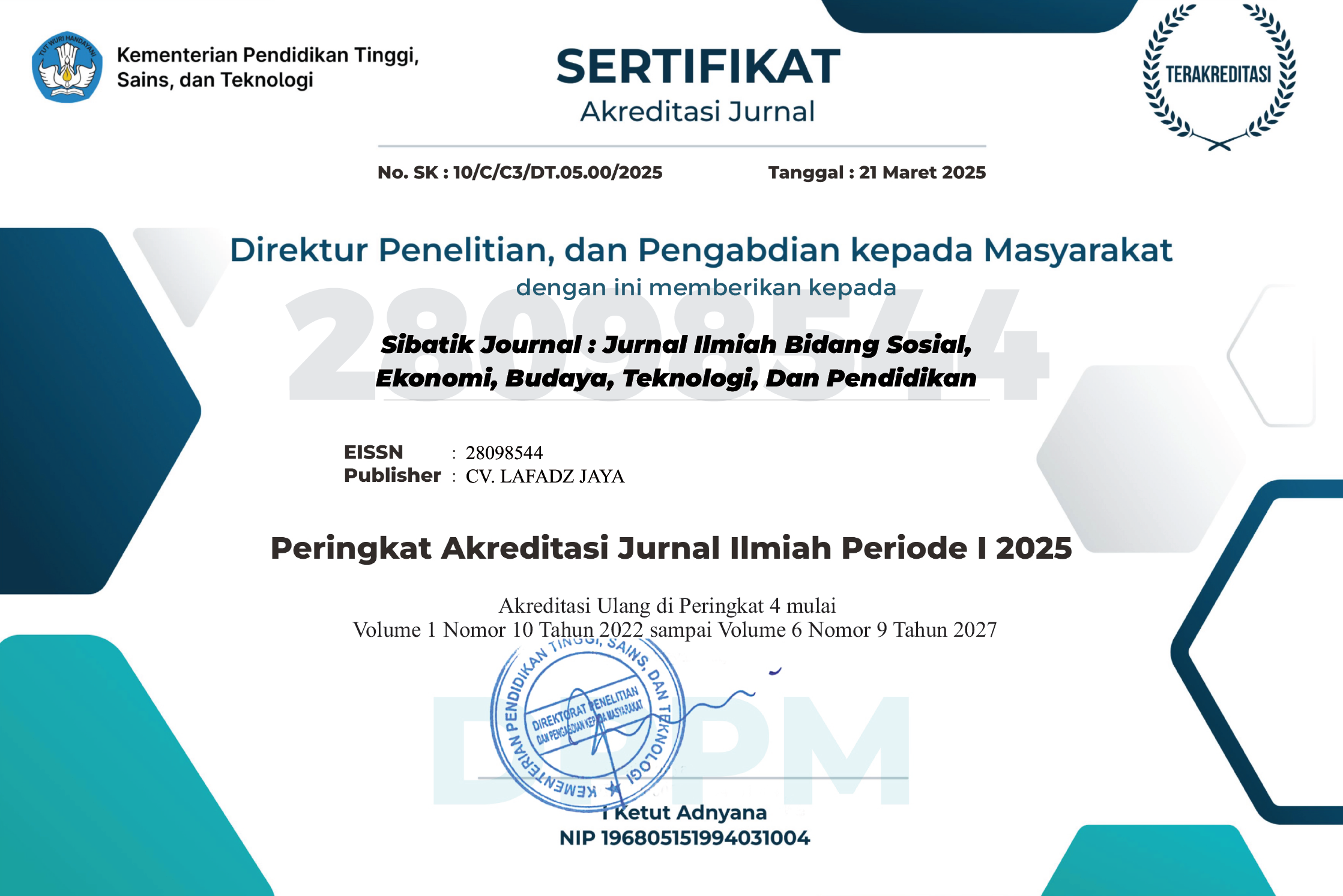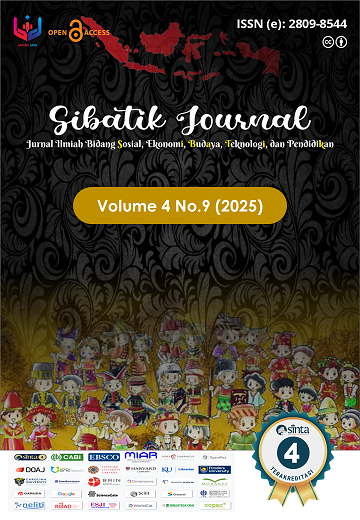ANALYSIS OF THE INFLUENCE OF ENVIRONMENTAL EXPENDITURE AND ENERGY CONSERVATION THROUGH GRDP ON ENVIRONMENTAL QUALITY INDEX ON JAVA AND BALI ISLAND
Main Article Content
Atika Estining Sholeha
Deky Aji Suseno
The objective of this paper is as follows: analyse the effect of government spending on environmental protection and energy conservation through Gross Regional Domestic Product (GRDP) on the Environmental Quality Index (EQI). This paper includes panel data on government spending on environmental protection and energy conservation as independent variables, GRDP as an intervening variable, and EQI as a dependent variable in Java and Bali Island in 2015-2023 using the Partial Least Squares Structural Equation Modeling (PLS-SEM) method. The results of the study found a significant positive effect between government spending on environmental protection on GRDP and energy conservation on EQI. When the government spends the budget on environmental programmes, the currency circulating in the community can create jobs, thereby increasing local revenue. In addition, increasing the use of energy, especially renewable energy, also supports the creation of a healthier and more sustainable environment. The results find no evidence for a positive effect of energy conservation on GRDP, government spending on environmental protection on EQI, and GRDP on EQI. We conjecture that weak institutional quality can explain these results.
Aykut, S., & Uzar, U. (2019). An empirical evaluation about the effects of environmental expenditures on environmental quality in coordinated market economies. Environmental Science and Pollution Research, 26, 23108–23118. https://doi.org/10.1007/s11356-019-05567-3
Algaeed, A. H. (2022). Public expenditure and economic growth: An empirical study of the energy sector in Saudi Arabia. Journal of Business and Economic Studies, 34(2), 112–125.
Al-ayouty, B. I. (2020). The effect of energy consumption on output : A panel data study of manufacturing industries in Egypt. European Journal of Sustainable Development, 9(3), 490–502. https://doi.org/10.14207/ejsd.2020.v9n3p490
Azwardi, A., Sukanto, S., Nazeli, A., & Arika, K. (2022). Environmental quality in Indonesia: Disruption by economic agents. Asian Journal of Business Environment, 12(1), 17–24. https://doi.org/10.13106/ajbe.2022.vol12.no1.17
Badan Pusat Statistik. (2023). Produk domestik regional bruto Provinsi XYZ menurut lapangan usaha.
Bappenas. (2020). Rencana aksi nasional penurunan emisi GRK sektor energi.
Bloomberg. (2015, October 26). Indonesia’s fires are out, but the climate damage continues. Bloomberg.com. https://www.bloomberg.com/news/articles/2015-10-26/indonesia-s-fires-are-out-but-the-climate-damage-continues
Boersma, T., Hagemann, D., & Makarov, I. (2023). Renewable investments, environmental spending, and emissions in Eastern Europe: A spatial economic analysis. Sustainability, 17(7), 3010. https://doi.org/10.3390/su17073010
Cui, L., Hunt, A., & Morley, B. (2021). The effectiveness of environmental spending in china and the environmental Kuznets curve. Sustainability, 13(21), Article 12141. https://doi.org/10.3390/su132112141
Daly, H. E. (1996). Beyond growth: The economics of sustainable development. Beacon Press
Diniyanti, R., & Halimatussadiah, A. (2020). Mampukah anggaran mengendalikan deforestasi di kawasan konservasi?. Jurnal Analisis Kebijakan Kehutanan, 17(2), 93–107.
Ercolano, S., & Romano, O. (2018). Spending for the environment: General government expenditure trends in Europe. Social Indicators Research, 138(3), 1145–1169. https://doi.org/10.1007/s11205-017-1695-0
European Union Panel Study. (2022). Rethinking economic growth policies in the context of sustainability: Panel data analysis on pollution as an effect of economic development in EU countries. Sustainability, 15(22), 15940. https://doi.org/10.3390/su15221415940
Esen, Ö. (2017). Does more energy consumption support economic growth in net energy-importing countries?. Journal of Economics, Finance and Administrative Science, 22(42), 75–98. https://doi.org/10.1108/JEFAS- 01-2017-0015
Fadillah, R., Rahmawati, A., & Yuniarti, I. (2024). Dampak pengeluaran pemerintah dan emisi karbon terhadap pertumbuhan ekonomi di Indonesia: Analisis VAR. Jurnal Ekonomi dan Kebijakan Publik, 15(1), 45–60.
Fadilah, Z. N., & Rahajeng, A. (2024). Pengaruh faktor ekonomi terhadap kualitas lingkungan hidup: Studi kasus DI Yogyakarta 2015–2023. D4 Pembangunan Ekonomi Kewilayahan, Universitas Gadjah Mada. https://etd.repository.ugm.ac.id/penelitian/detail/242228
Frontiers in Environmental Science. (2022). Green energy investment, renewable energy consumption, and carbon neutrality in China. Frontiers in Environmental Science, 10, Article 960795. https://doi.org/10.3389/fenvs.2022.960795
Gong, J., Zhang, Y., & Wang, Q. (2022). Fiscal expenditure on environmental protection and green economic growth: Evidence from Asian countries. Journal of Cleaner Production, 347, 131245. https://doi.org/10.1016/j.jclepro.2022.131245
Grossman, G. M., & Krueger, A.B. (1992). Environmental impacts of a North American Free Trade Agreement (NBER Working Paper No.3914). National Bureau of Economic Research. https://doi.org/10.3386/w3914
Gyimah, J., Fiati, M. K., Nwigwe, U. A., et al. (2024). The adoption of renewable energy towards environmental sustainability: Evidence from partial least square structural equation modelling (PLS‑SEM). PLOS ONE, 19(1), e0295563. https://doi.org/10.1371/journal.pone.0295563
Hair, J. F., Hult, G. T. M., Ringle, C. M., & Sarstedt, M. (2019). A primer on partial least squares structural equation modeling (PLS-SEM) (2nd ed.). Sage Publications.
Halkos, G. E., & Paizanos, E. A. (2017). The channels of the effect of government expenditure on the environment: Evidence using dynamic panel data. Journal of Environmental Planning and Management, 60(1), 135–157. https://doi.org/10.1080/09640568.2016.1145107
Harris, Jonathan M. (2013). Green Keynesianism: Beyond standard growth paradigms. In R. B. Richardson (Ed.), Building a green economy: Perspectives from ecological economics (pp. 67-86). Michigan State University Press.
Hermawan, W. (2020). Pengaruh belanja pemerintah pusat untuk fungsi lingkungan hidup terhadap pertumbuhan ekonomi Indonesia. Quantitative Economics Journal, 6(1), 1–15. https://doi.org/10.24114/qej.v6i1.17533
Huang, J. T. (2018). Sulfur dioxide (SO2) emissions and government spending on environmental protection in China: Evidence from spatial econometric analysis. Journal of Cleaner Production, 175, 431–441. https://doi.org/10.1016/j.jclepro.2017.12.001
IQAir. (2019). 2019 World Air Quality Report: Region & city PM2.5 ranking. https://www.iqair.com/world-most-polluted-countries
Kabullah, M.I., Koeswara, H., & Rahmadi, D. (2020). Alienasi kebijakan anggaran Provinsi Riau dalam pencegahan dan pengendalian kebakaran hutan dan lahan. Jurnal Administrasi Dan Kebijakan Publik, 5, 173–192. https://doi.org/10.25077/jakp
Keynes, J. M. (1936). The General Theory of Employment, Interest and Money. Macmillan.
Kock, N. (2015). WarpPLS User Manual: Version 5.0. ScriptWarp Systems.
Kock, N., & Lynn, G. (2012). Lateral collinearity and misleading results in variance-based SEM: An illustration and recommendations. Journal of the Association for Information Systems, 13(7), 546–580.
Krajewski, P. (2023). Public environmental protection expenditure and economic growth: Evidence from Central and Eastern Europe. Prace Naukowe Uniwersytetu Ekonomicznego we Wrocławiu, 67(1), 64–78. https://ph.pollub.pl/index.php/preko/article/view/4948
Liu, J., Zhao, M., & Wang, Y. (2020). Impacts of government subsidies and environmental regulations on green process innovation: A nonlinear approach. Technology in Society, 63, 101417. https://doi.org/10.1016/j.techsoc.2020.101417
Ma, M. (2024). The application of Green GDP and its impact on global economy and environment. arXiv preprint arXiv:2409.02642. https://arxiv.org/abs/2409.02642
Ma, S., García Sánchez, I. M., & Navarro Galera, A. (2017). Economic growth and environmental impacts: An analysis based on a composite index of environmental damage. Ecological Indicators, 76, 119–130. https://doi.org/10.1016/j.ecolind.2016.12.028
Marina, M., Dinu, M., Socol, A., & Socol, C. (2020). Renewable energy consumption and economic growth : Causality relationship in Central and Eastern European countries. Renewable Energy Reports, 1, 1–29.
Maulida, R. N., & Raisa, N. (2021). Pengaruh APBD fungsi lingkungan hidup terhadap kualitas lingkungan di Indonesia. Penelitian Pascasarjana FEB UI. Retrieved from https://psb.feb.ui.ac.id/index.php?id=80587
Munthe, S. (2023). Pengaruh belanja pemerintah terhadap PDRB di Sumatera Utara: Pendekatan ekonometrika. Jurnal Ekonomi Pembangunan Regional, 11(2), 121–133. https://journal.usu.ac.id/index.php/jepr
MDPI. (2021). Assessing the impact of green public consumption policy on environmental equity: Evidence from China. Sustainability, 13(18), 10241. https://doi.org/10.3390/su131810241
MDPI. (2021). Measuring the role of financial development in the economic growth effect on a composite environmental quality index. Environmental Science and Pollution Research. https://doi.org/10.1007/s11356-021-15047-2
MDPI. (2023). The impact of renewable energy consumption on environmental quality in Central European countries: The mediating role of digitalization and financial development. Energies, 16(20), 7041. https://doi.org/10.3390/en16207041
Moshiri, S., & Daneshmand, A. (2020). How effective is government spending on environmental protection in a developing country?: An empirical evidence from Iran. Journal of Economic Studies, 47(4), 789–803. https://doi.org/10.1108/JES-12- 2018-0458
Musgrave, R.A. (1959). The theory of public finance: A study in public economy. New York, NY:Mc-Graw-Hill
Pigou, A.C. (1920). The economics of welfare. Macmillan and Co. https://www.econlib.org/library/NPDBooks/Pigou/pgEW.html
Pramudiyanto, A. S., &Suedy, S. W. A. (2020). Energi bersih dan ramah lingkungan dari biomassa untuk mengurangi efek gas rumah kaca dan perubahan iklim yang ekstrim. Jurnal Energi Baru Dan Terbarukan, 1(3), 92–105. https://doi.org/10.14710/jebt.2020.9990
Rahmi, C., Hartati, E., & Lismayanti, D. (2022). Lingkungan dan energi; menyongsong era berkelanjutan. Dharmas Education Journal, 3(4), 205–213.
Revika, R., & Yenni, M. (2021). The effect of energy consumption on economic growth in Indonesia: An ARDL approach. Jurnal Ekonomi dan Pembangunan Indonesia, 22(1), 25–38.
Samir, M. A., Hassan, R., & Bakry, M. I. (2025). Fossil fuel subsidies and economic growth: Evidence from panel data of energy-exporting countries. Economic Research Studies, 19(1), 45–62. https://doi.org/10.2478/ers-2025-0004
Sarrakh, N. A., AlShahrani, M., & Alzahrani, K. (2020). Economic impact of energy subsidies: A computable general equilibrium analysis for Saudi Arabia. Energy Policy, 138, 111238. https://doi.org/10.1016/j.enpol.2019.111238
Seri, C., & de Juan Fernandez, A. (2021). The relationship between economic growth and environment: Testing the EKC hypothesis for Latin American countries. arXiv preprint. https://arxiv.org/abs/2105.11405
Springer. (2025). The impact of green and energy investments on environmental sustainability in China: A technological and financial development perspective. Environmental Modeling & Assessment. https://doi.org/10.1007/s10666-025-10040-2
Stern, D. I. (1993). Energy and economic growth in the USA: A multivariate approach. Energy Economics, 15(2), 137–150. https://doi.org/10.1016/0140-9883(93)90033-F
Stern, N., Zenghelis, D., & Rydge, J. (2024). Investing in a just transition: The economic case for climate action in the UK. London School of Economics and Political Science (LSE). https://www.lse.ac.uk
Tenenhaus, M., Vinzi, V. E., Chatelin, Y. M., & Lauro, C. (2005). PLS Path Modeling. Computational Statistics & Data Analysis, 48(1), 159–205
Thailand Development Research Institute (TDRI). (2022). The effects of energy subsidy reforms on Thailand’s macroeconomic indicators: A CGE analysis. Bangkok: TDRI Press.
Ula, T., &Affandi. (2019). Dampak konsumsi energi terbarukan terhadap pertumbuhan ekonomi: Studi di Asia Tenggara. Journal of Economics Science, 5(2), 26–34.
U.S. Environmental Protection Agency (EPA). (2012). Environmental Quality Index (EQI) Documentation.
Verisk Maplecroft. (2021, March 3). Climate Change Vulnerability Index 2021. Maplecroft.com. https://www.maplecroft.com/insights/analysis/asian-economies-at-high-risk-from-climate-change/

























